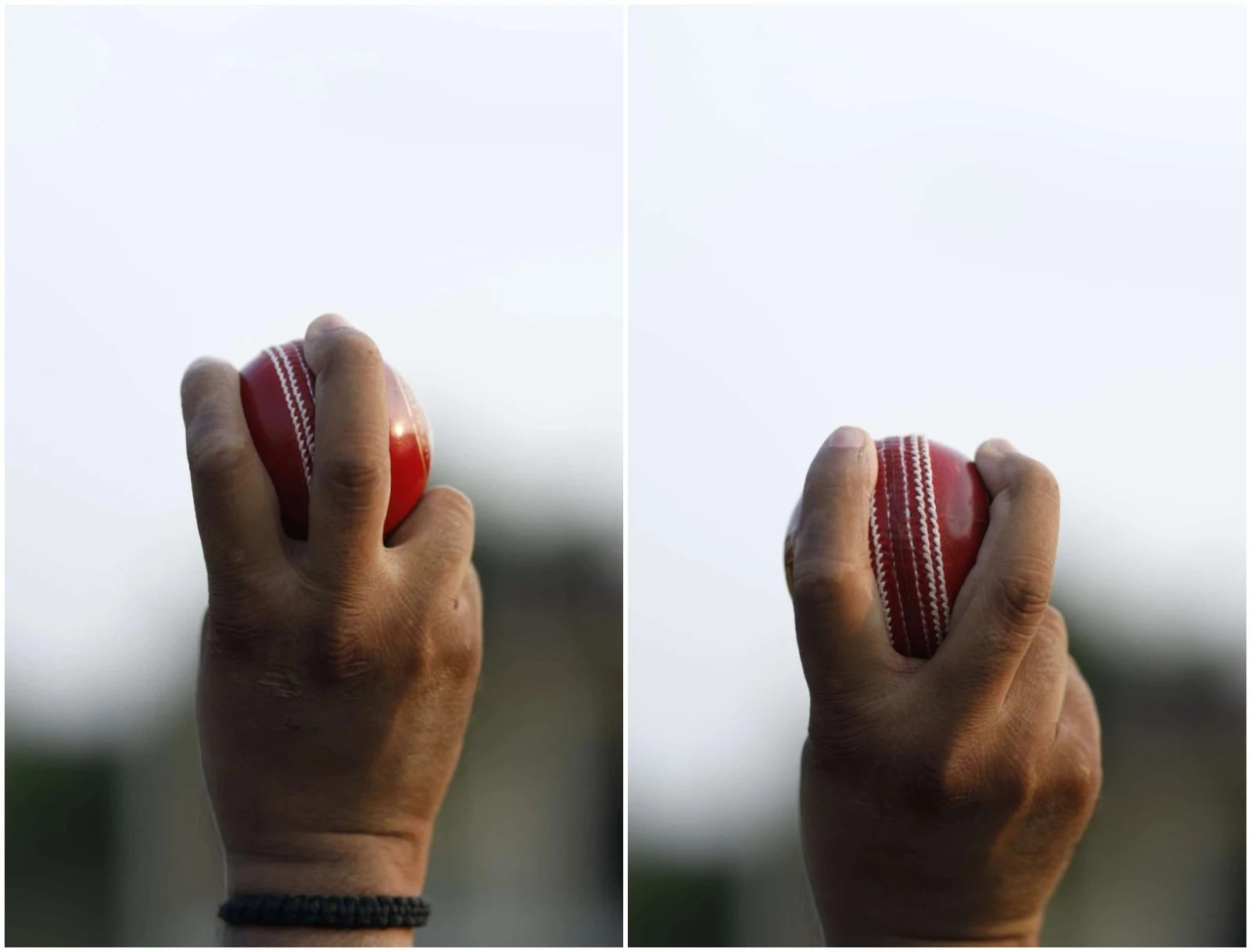Fast bowling in cricket is a relentless activity, but they are the artists who can craft the most unpredictable and destructive deliveries. They can deliver a surprise bouncer, which hits the helmet of the batsman, or they can throw a toe-crushing yorker, which the batter has no answer to. But one ability that fast bowlers have is the ability to move the leather ball in the air and keep the batters bamboozled. Both Inswing deliveries and outswing bowling are lethal and elegant to watch. A prime example of this is James Anderson. His ability to pitch those pin-point deliveries, both that come in and go away from the batter, has earned him the most wickets in international cricket history as a fast bowler.

Credit: ESPNCricinfo
However, the art of swinging the delivery is tough and involves a lot of technicalities and a major role in physics. But in this article by ZAP, we’ll reveal all the secrets of In Swing, Out Swing and Reverse Swing bowling in cricket.
What is Swing Bowling in cricket, and how does it happen?

Credit: Social News XYZ
Conventional Cricket Swing Bowling Technique:
Conventional Swing bowling is a vital fast bowling technique where you use the shiny side, the seam and your wrists, causing it to move in the air. The movement of the ball can be towards or away for the batsman, depending on the seam position and which side the shiny side is. For a right-arm fast bowler bowling to a right-hand batter, inswing is a delivery when the ball moves in towards the body and batting pads of the batter. The inswing delivery in cricket is often referred to as “bringing the ball back into the batsman”. When the delivery comes in quickly with a large deviation from its original path, it is also called a banana delivery. An outswing is one that goes away from the batter. An outgoing delivery usually takes the edge of the cricket bat and goes straight into the gloves of the wicket keeper's gloves or in the hands of the slip fielder.
Reverse Swing Bowling:
Reverse swing is a mysterious and challenging form of bowling and, at times, is unplayable for the batters. Unlike conventional bowling, the reverse happens when the ball moves in the opposite direction of its seam.
The Science of Swinging Deliveries:

Credit: Cricket@IITB
The skill of swing bowling relies on how a fast bowler uses his wrist position and the seam of the leather, which generates differential air pressure and produces a late movement. The primary factors that influence the deviation are the seam position, the condition of the ball, and the wrist position. Aerodynamics and physics are the foundations of this skill.
How to bowl an In Swing Ball in Cricket:
In Swing Fast Bowling Grip:

How you hold the ball in your hand plays an important role in inswing bowling. The shiny side should face the offside, and the rough side will face the leg side. When the seam is angled towards the fine leg fielding position, it creates turbulence on the non-shiny side, which makes the ball swirl inwards towards the batter. Hold the ball with your index and middle finger close together on the seam, with your thumb gently holding the underside of the ball.
Wrists Position and Seam Orientation:
Once you’re done with your run-up and bowling action, remember that your wrist position at the point of release is critical. Use your wrists to angle the ball inwards when releasing, which will create more movement. Also, ensure that the seam is consistently angled towards the leg slip to maintain in-swing movement. A slight change in wrist position can lead to erratic results.
Speed and Length
The pace and length of the delivery are important, too. If you bowl it very short and quick, the ball will not have enough time to deviate, and it’ll just be a normal short delivery. So, hit the right length, around good to full length at about 135kmph, which will allow the leather to move late and surprise the batsman. Also, where the ball hits on the pitch plays an important role. You cannot bowl an ouswtinger ay outside the off stump as you'll give the batter enough space and to leave the ball, neither can you bowl an inswinger at leg stumps or it will fly off for a wide delivery. So keep it in a line where the ball finishes very close to the stumps, so that you don't give the batter any room and cramp him to claim his wicket.
Inswing Bowling in Cricket - Step by Step:
- Hold the ball with the seam pointing upwards and towards the direction of "fine leg."
- Position the shiny side towards the "off-side" of the pitch
- Keep the seam vertical and tilted as it travels through the air
- The ball will then swing or curve from the off-side of the pitch towards the leg side, which is where a right-handed batsman stands
How to bowl Out Swinging Deliveries in Cricket:
Out Swing Bowling Grip:

To achieve an outswing, you must hold the cricket ball correctly. Place your index and middle fingers close together on the seam while the thumb rests lightly against the ball. The seam should be angled diagonally, pointing towards the slips. The rough side of the ball will be towards the off side, and the shiny side will be towards the leg side.
Wrists Positions and Seam Orientation:
Getting the wrist in the ideal position and how you use it is crucial to producing outside movement. With the seam facing the slips, your wrist should be tilted towards the leg side. The seam's position influences the direction of the deviation, so mastering this aspect is crucial.
Speed and Length:
The right speed is very important, as well as the line and length, so try to pitch it at the same spot as the inswinger. The ideal line and length should be at good to full length in line with the off stump or just outside off. This is the ideal length for swingers, too, and pitching it there will always create confusion for the batsman, whether it will come in or whether it will go out and remain straight.
Outswing Bowling in Cricket - Step by Step:
- Hold the ball with the seam pointing upwards and towards the direction of the "third man."
- Position the shiny side towards the "leg side" of the pitch
- Keep the seam vertical and tilted as it travels through the air
- The ball will then swing or curve from the leg side of the pitch towards the offside, which is where a right-handed batsman stands.
For an ideal outswinger that takes the edge of the bat, you need a wicketkeeper and a slips fielder that doesn't drop any catch. Here are two articles you should read to be a top quality fielder.
Wicket keeping Tips and Techniques | Cricket Fielding Techniques
How to Bowl Reverse Swing Deliveries in Cricket:

Credit: Wisden
Reverse swing bowling works best in an ODI and Test Cricket Game when the ball is about 30-35 overs old. Reverse movement is lethal, like the ball moves from its trajectory at the last moment, leaving the batter in a fix. But do you know what’s special about this type of delivery? You can bowl a delivery that goes away from the batsman with an outswing grip with a new ball, but with an old ball and with the same grip, the ball will behave differently and move in towards it. That's why we call it reverse swing.
Reverse Swing Bowling Grip and Technique in Cricket - Step by Step:
- The leather should be worn, dry, and scuffed on one side, and the opposite side needs to be smooth, glossy, and heavy due to shine.
- Hold it in an outswing grip if you want to reverse inwards and vice versa.
- As the ball travels through the air, its seam should remain vertical and angled.
- The ball will travel towards the direction of the glossy side at high speeds.
To know more about how to swing a cricket ball, you need to understand in depth about how cricket balls are made. Read are articles about it and get to know more about cricket.
FAQ:
What is reverse swing in cricket?
Reverse swing in cricket is when the cricket ball swings in the opposite direction to conventional swing, typically occurring with an older ball.
How to swing a tennis ball?
You generally cannot swing the tennis ball by itself. Extreme pace can help in imparting swing. But if you wrap up one side of the tennis ball with a tape, then it has a shiny side and a rough side which can help in generating swing.
Who is the "King of Swing" in cricket?
Wasim Akram from Pakistan is often referred to as the Sultan Of Swing.
Who is the best swing bowler in the world?
The title of the best swing bowler can change according to personal choice, and recency bias but some players like James Anderson, Dale Steyn, Wasim Akram will definitely be a part of every person’s list of the best swing bowlers in the world.
Now that you've read about Swing Bowling Variations in Cricket, here are some more articles we recommend reading that will take your game to the next level.
Fast Bowling Variations | Spin Bowling Tips and Technique | Spin Bowling Variations | Cricket Exercises | Cricket Injuries and Prevention



Share:
How to play the Backfoot Drive in Cricket?
Ranking the Top 10 Best Swing Bowlers of All Time
1 comment
Munna